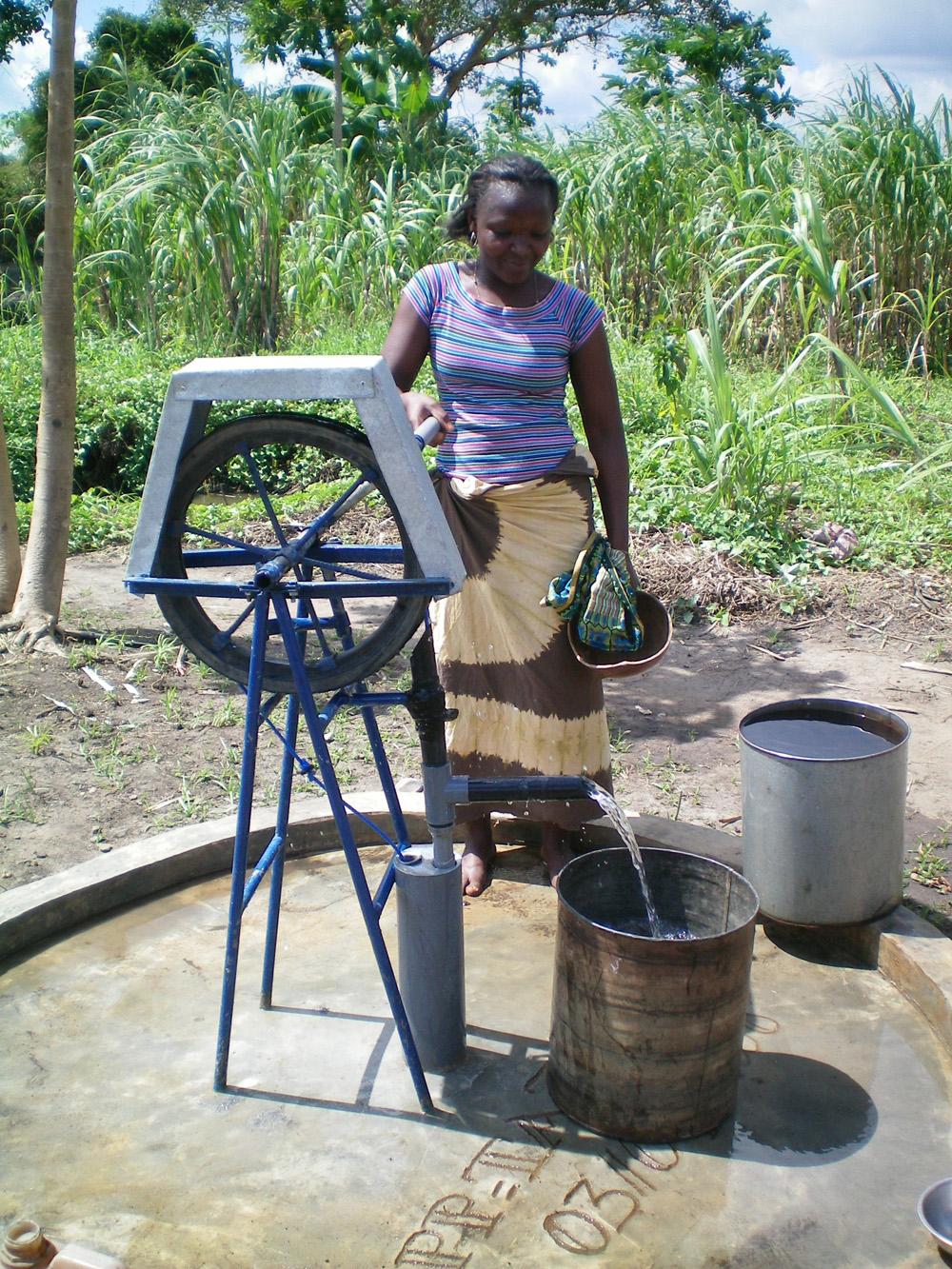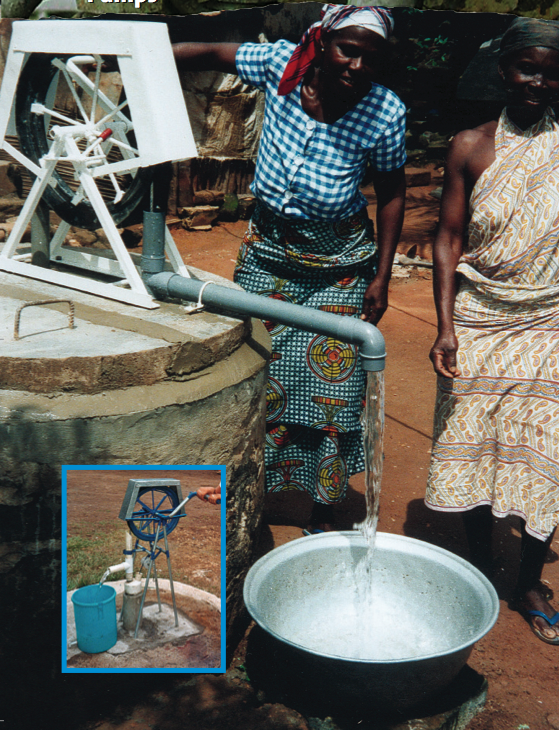Difference between revisions of "Rope pump"
| Line 101: | Line 101: | ||
* [http://www.youtube.com/watch?v=E1qIdvH1bvM Windmill powered rope pump in Nicaragua (S.J. Batchelor, 1999)] | * [http://www.youtube.com/watch?v=E1qIdvH1bvM Windmill powered rope pump in Nicaragua (S.J. Batchelor, 1999)] | ||
* [http://www.youtube.com/watch?v=9wWLuX8pmNA Rope Pump animation (Resource Development International Cambodia, RDI)] | * [http://www.youtube.com/watch?v=9wWLuX8pmNA Rope Pump animation (Resource Development International Cambodia, RDI)] | ||
| − | * [http://www.youtube.com/watch?v=KTuqHEVo2TA&feature=channel_page | + | * [http://www.youtube.com/watch?v=KTuqHEVo2TA&feature=channel_page Motorized rope pump on platform in Ethiopia, used to fill an overhead tank] |
| + | * [http://www.youtube.com/watch?v=-YE42YdLHVI&feature=channel_page Motorized rope pump in Burkina Faso, used for smalls scale irrigation.] | ||
==External links== | ==External links== | ||
| Line 113: | Line 114: | ||
* [http://www.wateraid.org/international/what_we_do/where_we_work/mozambique/2595.asp Rope Pump - WaterAid in Mozambique] | * [http://www.wateraid.org/international/what_we_do/where_we_work/mozambique/2595.asp Rope Pump - WaterAid in Mozambique] | ||
* [http://www.appropedia.org/Rope_pump Rope pump article at Appropedia] | * [http://www.appropedia.org/Rope_pump Rope pump article at Appropedia] | ||
| − | + | ||
==References== | ==References== | ||
{{Joinus}} | {{Joinus}} | ||
Revision as of 09:20, 11 August 2009
A Rope Pump consist of a PVC pipe with a rope though it, to which washers are attached which fit in the tube with a small clearance. A wheel above ground pulls the rope with the washers through the pipe. The water is held between the washers in the pipe, and is pulled to the surface. Rope pumps are very simple, and can be easily repaired. They are used for domestic water supply, irrigation and cattle watering. For wells down to 35 m, rope pumps are often five times cheaper and more sustainable than piston pumps.
History and social context
Because of its low cost, the pump is also popular for domestic use. A survey among 5,025 rural families in Nicaragua indicates that a rope pump increases income, even if used for domestic purposes only. Families with a pump earn US$ 220 per year more than families without a pump. In Nicaragua the pumps are now being produced commercially by 20 workshops.
Different models of Rope pumps were introduced in Africa. This introduction has not always been successful: in one projects over 80% of the pumps did NOT work after one year! However, with the "right" models and the "right" user training, up to 90% remain in operation in Africa, as the Victory model in Ghana and the Elephant model in Zimbabwe have proved.
Suitable conditions
A rope pump can be used to draw water from wells or boreholes. Applications include communal wells, houshold, irrigation, and cattle watering.
One person can draw water up to 35 m, two persons can pump to 60m (using a second crank). A rope pump can be driven by hand, windmill, motor, bicycle, and animals. A rope pump can pump 40 litres / min from 10 meters depth.
Some 70,000 rope pumps are in use in Nicaragua, 20,000 in Mexico, Honduras, Guatemala, El Salvador, Ethiopia, Ghana, Senegal, Tanzania, Zambia, Mozambique, Zimbabwe, Cambodia, India, Vietnam, and others. In total, the Rope pump is used in over 30 countries.
The pump can be used by single families, or up to 20 families (100 people).
| Advantages | Disadvantages/limitations |
|---|---|
| - Significantly cheaper (up to 5 times) than piston pumps. - If made well, one pump can supply up to 250 people as experiences in Nicaragua, Ghana and other countries indicate. However, suggested use is for maximum of 20 families (100 people) |
- The rope pump is easy to copy, but bad copying (materials, construction) leads to early break down.
- Lack of maintenance and installation errors, can lead to early wearing out or breakage of pump parts |
Technical specification
With different depths, different sizes of pump pipes are needed, otherwise the pumping becomes to heavy. See manuals on websites
of Practica Foundation and Connect International.
Similar to piston pumps, a cement slab and a good soak away are needed to avoid splash water becoming a cause for pollution.
Operation
Maintenance
Maintenance is limited, and consist mainly of repairing the rope or handle. Evaluations show that rope pumps on communal wells can be maintained by the users under certain conditions. One of the main conditions is a very high level of community coherence and responsability and the absence of alternatives water sources. If the rope pump technology is introduced properly, like often is the case with the Zimbabwe Elephant Rope pump, up to 90% of rope pumps remain operational, even after many years.
Manufacturing
Cost
- The Rope Pump costs between US$ 30-150 depending on model, location of production, and cost of materials and labour.
- Cost of introduction: between US$ 10,000-30,000 per project, including 20 pumps, engineering and hands-on training.
- Rural water programme: US$ 150,000-200,000 per project, including 1,000 pumps, start up of production facility and hands-on training.
Country experiences
In 2008, rope pumps are used in over 30 countries. Below the experiences in Nicaragua, Zimbabwe and Ghana are listed.
Nicaragua Some 70.000 rope pumps have been installed since 1990. The shift from imported piston pumps of 600$ to locally produced rope pumps of 70$ has doubled rural water supply in ten years, much faster than countries that apply piston pumps. Users do the maintenance and over 95% of the pumps remain in operation. The rope pump has been adopted as the standard water pump by the government.
Zimbabwe A rope pump model called the Elephant Pump was introduced by the organisation Pump Aid in 1990. The main difference with the traditional rope pump is the solid round structure around the wheel, to protect the well and to avoid splashing. Now some 3,000 pumps serve 950,000 people and some 95% of the pumps are working. Many more pumps are planned to be installed before 2015 and if this can be realized, this will reach 3 million more people.
Ghana The first experiences with rope pumps in Ghana were discouraging. In a World Bank funded project, 80% did not function after one year because of lack of user involvement and production errors. After improvements some 1.600 pumps were installed, but it was not accepted as an alternative for a standard community handpump.
Malawi, Blantyre trials Several rope pumps were introduced in order to provide a better alternative for the Afridev Community handpump, which is the standard handpump in Malawi. The Afridev is not popular due to many breakdowns and not available spare parts, especially in the more remote areas. However, the rope pumps also broke down many times, sometimes several times per month, due to the high number of users and was therefor not considered by the users as a good alternative for a community pump, although repairs were possible. Another disadvantage mentionned was that children found it difficult to pump and sometimes got hurt when the handle security break system was not functioning (in that case the handle turns back with a high speed due to the weight of the water in the riser pipe). The communities now prefer a more reliable handpump than the Afridev, with less need for spares.
Mozambique As in Malawi, the rope pump was seen as a viable alternative to the Afridev which is generally the official pump of choice. WaterAid had first introduced a bucket and windlass system in the Niassa provice as an alternative due to the high failure rate of Afridev pumps, but the Mozambican government refused to accept these as official community water supplies. WaterAid, in partnership with the Swiss Agency for Development Cooperation (SDC), UNICEF, CARE and the Government of Mozambique, therefore began a lengthy process of piloting a robust community rope pump, first relying on support from Bombas de Mecate in Nicaragua, but later adapting the design from Madagascar. The new model meets a number of key well protection and water quality criteria set down by the development team. Three manufacturers are now in operation in three provinces and through a process of skill sharing improvements have been made to the design resulting in a robust high quality model. A manufacturing standard has also been produced with the help of SKAT. The final stages of this process are currently underway which include the final approval of the pump as well as the licensing of the manufacturers by the Governments standards laboratory.
There are now more than 300 rope pumps installed across three provinces (Niassa, Cabo Delgado and Zambezia)and in Niassa particularly WaterAid funded projects continues to offer communities a choice of either the Rope Pump of the Afridev. In addition the installed pumps are monitored twice per year in order to better understand the pumps sustainability.
Apart from this initiative, PumpAid has also been active in the Chimoio province installing Elephant Pumps which are also rope pumps.
To date, the Government of Mozambique does not see the Rope Pump as a community pump. The results of all testing is that it is only considered as a solution for shallow wells for 1 to 5 families. Actual commercial cost of a Mozambiqcan Rope Pumps varies between 300 and 400 US$.
Please see the external links below for further information.
Burkina Faso WaterAid in Burkina Faso is also currently developing a rope pump model suitable to local conditions. This project has resulted in a renewed understanding across WaterAid of the need to ensure that rope pumps destined for community water supplies require high quality manufacturing and installation techniques in order for them to remain sustainable. WaterAid now intends to renew its efforts across the organisation to improving the quality of rope pumps in countries where this is supported. An international skills and knowledge sharing event to which all rope pump supporters and manufacturers will be invited is being considered for 2009.
Manuals
- Rope Pump production manual, produced by PRACTICA and ETC Foundation. It has 86 pages and contains detailed instructions.
- Construction manual Connect International.
Movies
- Rope pumps around the world (Connect International, Netherlands, 2008)
- Small scale irrigation with a rope pump, Zambia (Connect International, Netherlands, 2008)
- Hand drilled borehole and rope pump in Tanzania (Connect International, Netherlands, 2008)
- Windmill powered rope pump in Nicaragua (S.J. Batchelor, 1999)
- Rope Pump animation (Resource Development International Cambodia, RDI)
- Motorized rope pump on platform in Ethiopia, used to fill an overhead tank
- Motorized rope pump in Burkina Faso, used for smalls scale irrigation.
External links
- Rope pumps: out-perform conventional handpumps on most counts in Ghana test. Article on IRC.
- Rope pump: local production and installation capacity being developed in Senegal. Article on IRC.
Overview of community handpumps at the RWSN website
- Low-cost pump alternatives for rural communities in Honduras (rope- and EMAS pumps), SKAT website
- Pump Aid works in Malawi and Zimbambwe with the Elephant pump, a kind of rope pump.
- www.ropepump.com
- Ideas at Work, Cambodia
- Rope Pump - WaterAid in Mozambique
- Rope pump article at Appropedia
References

|





